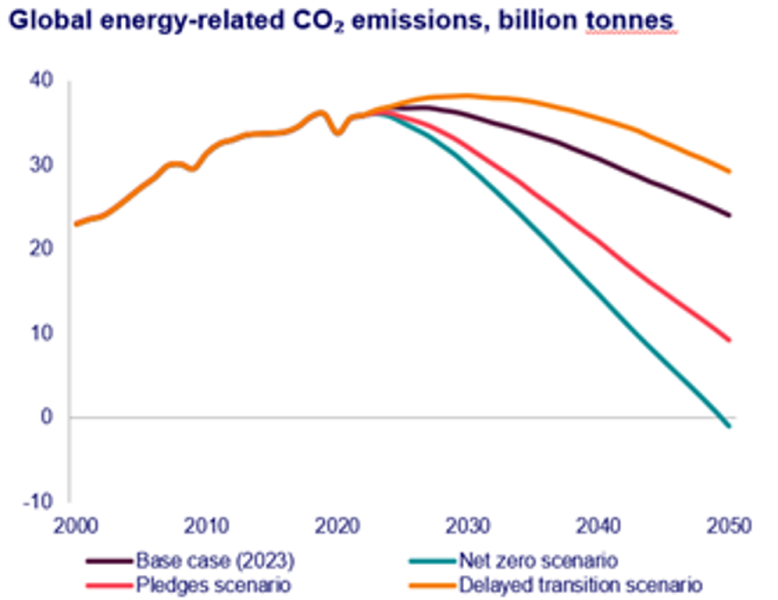A five-year delay to the energy transition could see the global average temperature rise to 3-degree Celsius above pre-industrial levels, according to Wood Mackenzie’s latest analysis: ‘A delayed energy transition’.
Wood Mackenzie’s delayed energy transition scenario, which analyzed the impact a five-year delay might have on global decarbonization efforts, expects annual average spending to fall to US$1.7 trillion. This is 55% lower than Wood Mackenzie’s net zero 2050 scenario*, which maps out what’s required to meet the Paris Agreement targets.
In terms of total investment, a delayed transition could cost up to US$48 trillion, a significant decrease from Wood Mackenzie’s net zero scenario, which estimates a total of US$75 trillion. The oil and gas sector CAPEX rises to 31%, as power sector spending is expected to remain at its current level of 60%, in a delayed transition. Spending could fall to under 10% in the net zero scenario if the power sector gets 80% of total spend.
For metals and mining sectors, CAPEX is the most resilient and remains around 6% of the total cross all scenarios. In contrast, despite their key role in the overall energy transition, investment into hydrogen and carbon, capture, utilization, and storage (CCUS) drop to 2%, compared to 8% in Wood Mackenzie’s net zero scenario.
“With half of the global population heading to polls in 2024, political realities and climate scepticism in the major emitting countries, such as the US and Europe, could reduce the support for the transition as voters seek economic security and price stability,” said Prakash Sharma, Vice President, Scenarios and Technologies at Wood Mackenzie, and author of the report.
“The global stocktake at COP28 in December 2023 also confirmed that no major country was on track to meet the Paris aligned commitments and that strong policy action and capital investment were necessary to accelerate the transition. Indeed, Europe and the UK have already pushed back 2030 climate goals and other countries may follow suit,” Sharma added.
According to the scenario, emissions are expected to peak in 2032 and the remaining carbon budget for a 1.5 ˚C world will be used up by 2027, further weakening countries’ ability to deliver the Paris Agreement goals in time by 2050.
Renewables-led electrification looks increasingly more challenging, in Wood Mackenzie’s delayed scenario. Solar and wind dominate power markets in the longer term, but near-term additions are slowed due to transmission bottlenecks. Unabated thermal supply provides much of the flexible generation to balance power grids.
Higher interest rates and supply chain bottlenecks raised renewables costs by 10% to 20% in recent years. Expensive renewables costs will further delay low-carbon hydrogen cost declines, reducing demand to 100 million tonnes (Mt) in 2050, nearly 50% lower than the base case.
A slower transition means carbon capture and removal technologies would need to play a dominant role in restoring the carbon balance and achieving long-term climate goals. CCUS uptake reaches 225 Mt by 2030 in Wood Mackenzie’s delayed transition and continues to scale as policy incentives expand and storage infrastructure is built.
In the delayed transition scenario, oil demand peaks at 114 million barrels per day (mb/d) in 2033, nearly 6 mb/d higher than the base case due to slower electric vehicle (EV) adoption outside China. Gas demand peaks at 4,536 billion cubic meters of natural gas (bcm) in 2045, nearly 100 bcm higher than the base case. Meanwhile coal demand falls slowly, keeping a 3% higher trajectory than the base case in this decade.
“Lower renewables and hydrogen production create headroom for additional gas demand growth, but coal’s resilience limits upside. Commodity markets look tighter and volatile for longer unless investment in supply picks up,” Sharma said.
Wood Mackenzie published its most recent base case outlook in September 2023. Since then, the risks of delays in the transition to low-carbon energy have grown, particularly because of shifts in policy and politics in several key economies. As a result, we are publishing here a Delayed Energy Transition scenario, looking at the implications of a five-year delay to global decarbonization efforts.

